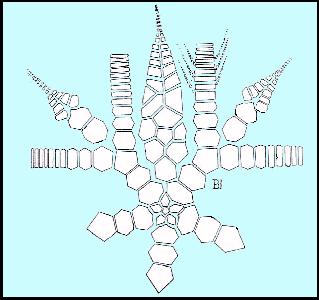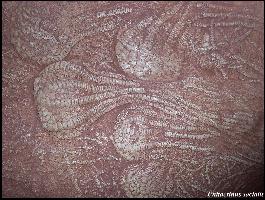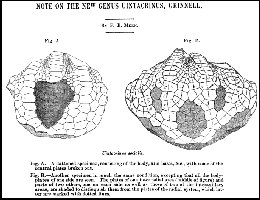Notes on Uintacrinus
socialis Grinnell.
______________________
While a member of the late Professor Mudge's party in
western Kansas, during the summer of 1875, the writer was fortunate in finding in the
Niobrara chalk a number of specimens of a crinoid which were notable from their very
rarity. During that same season, whether before or after I do not now remember, other
specimens of the same kind were discovered by Prof. Mudge and Mr. Geo. Cooper, all of
which, as well as those found by myself, had been more or less exposed and weathered. A
very few of these found their way into different collections, and among them were those
which serve as the types of genus and species.* An imperfect specimen of this genus had
been previously discovered by Marsh in the Uinta Mountains, but so incomplete that its
affinities could not be decisively made out. ("In a stratum of yellow calcareous
shale which overlies the coal series conformably, a thin layer was found full of Ostrea
congesta Conrad, a typical Cretaceous fossil; and, just above, a new and very
interesting crinoid, allied apparently to the Marsupites of the English
chalk." Marsh, Amer. Journ. Sci., "March, 1871.) Because of this previous
discovery, the generic name was chosen, but there is no proof that the species, at least,
are identical.
During the season of 1891, Prof. E. E. Slosson, while
a member of the Kansas University expedition in western Kansas, was so fortunate as to
discover a most remarkable colony of this crinoid, by far the best yet known, in the
vicinity of Elkader, on the Smoky Hill river. While all the colonies hitherto discovered
have been exposed and more or less weathered, the present one was found in position,
covered by the soft blue shale. The animals had lived so closely together that their very
long arms had become inextricably entangled, and, by consolidation, had formed a dense
calcareous plate, about one-third of an inch in thickness in the middle of the plate, but
thinning out at the margin. About one-half of the thin slab as thus formed had been washed
away; the remainder, as now restored in the University Museum, measures about six feet by
three or four, and has, upon its under side, nearly one hundred of the crinoids, the
greater part of which are perfectly preserved. The calyces all lie flattened out, showing,
in some cases, the basal plates, but, as might be expected, never the upper or ventral
___________
*Grinnell, Amer. Journ. Sci. xii, 81, July, 1876.
(19) KAN. UNIV. QUAR., VOL. II, NO. 1, JULY,1894.
20
KANSAS UNIVERSITY QUARTERLY.
portions. The interlacing of the arms prevents the tracing of any to the
extremity. A photograph of a portion of the slab will be given in a future number of the QUARTERLY; for the present, the following description and figure, by Mr. B.
H. Hill, student in paleontology in the University, will be of interest.
The horizon of Uintacrinus in Kansas seems to
be confined to near the middle of the Niobrara. All the specimens hitherto discovered, of
which I have any knowledge, have come from the vicinity of Elkader on the Smoky Hill,
though in all probability, they will be found on both the Solomon and Saline.
S. W. WILLISTON.
In
life, Uintacrinus socialis was evidently subglobose in shape, and about two inches
in diameter. In place of the sub-basal plates of the stemmed crinoids, there is a small,
five-sided, centro-dorsal plate, around which are grouped five pentagonal basals, the two |
longest sides of
which meet in a superior angle. The radials are fifteen in number, arranged in series of
three. The first radial is the broadest, broader than high, heptagonal in shape, the third
pentagonal. The two superior facets of the third radials give support to two series of
secondary radials, the proximal three of which are its supports. The arm plates are thin
and round, and radiate in structure. The arms themselves are ten in number.
NOTES ON UINTACRINUS SOCIALIS GRINNELL
21
In the
colony there is one arm which I have traced for seventeen inches, and a comparison of its
last distinguishable plates with the terminal ones of the other arms makes it evident that
the arms must have been over two feet in length, as stated by Grinnell. They have
well-developed pinnulę beginning at the base of the arm, where they are very large. They
arise one from each plate, but alternating on the two sides of the ambulacral groove.
Grinnell described what he believed to be interbrachial and interradial arms, but it seems
certain that he was in error in this respect, having mistaken the pinnulę for these arms.
The interradials are usually seven in number. The first is hexagonal and lies between the
first and second radials of two series. The other six are also hexagonal, and in life may
have been arranged in pairs, but are preserved in the specimens in irregular groups of
four. The interbrachials are two in number, heptagonal in shape, and lie, respectively,
between the first and second, and the second and third secondary radials of the two arms.
From the shape
of the crinoid, its globose form and long, heavy arms, one would hardly expect to find any
of the ventral plates exposed, and such is the case. Nor has it been possible to expose
them by dissecting away the plates.
B. H. HILL. |




